
Krönleins
Encyclopedia

Krönleins Brewery is a Swedish
Sweden
Sweden , officially the Kingdom of Sweden , is a Nordic country on the Scandinavian Peninsula in Northern Europe. Sweden borders with Norway and Finland and is connected to Denmark by a bridge-tunnel across the Öresund....
brewery
Brewery
A brewery is a dedicated building for the making of beer, though beer can be made at home, and has been for much of beer's history. A company which makes beer is called either a brewery or a brewing company....
founded in 1836 by Anders Julius Appeltofft in Halmstad
Halmstad
Halmstad is a port, university, industrial and recreational city at the mouth of Nissan in the province of Halland on the Swedish west coast. Halmstad is the seat of Halmstad Municipality and the capital of Halland County...
, Sweden
Sweden
Sweden , officially the Kingdom of Sweden , is a Nordic country on the Scandinavian Peninsula in Northern Europe. Sweden borders with Norway and Finland and is connected to Denmark by a bridge-tunnel across the Öresund....
.
History
Krönleins Brewery was founded on February 15, 1836 when grocery businessman Anders Julius Appeltofft bought an old half-timbered hospital, or "curhuset", at Stora Torg in HalmstadHalmstad
Halmstad is a port, university, industrial and recreational city at the mouth of Nissan in the province of Halland on the Swedish west coast. Halmstad is the seat of Halmstad Municipality and the capital of Halland County...
, Sweden
Sweden
Sweden , officially the Kingdom of Sweden , is a Nordic country on the Scandinavian Peninsula in Northern Europe. Sweden borders with Norway and Finland and is connected to Denmark by a bridge-tunnel across the Öresund....
, and converted it into an office
Office
An office is generally a room or other area in which people work, but may also denote a position within an organization with specific duties attached to it ; the latter is in fact an earlier usage, office as place originally referring to the location of one's duty. When used as an adjective, the...
and a bar
Bar (establishment)
A bar is a business establishment that serves alcoholic drinks — beer, wine, liquor, and cocktails — for consumption on the premises.Bars provide stools or chairs that are placed at tables or counters for their patrons. Some bars have entertainment on a stage, such as a live band, comedians, go-go...
. The beer was brewed in the building next door. For the first ten years he made Svensköl, a traditional sweet, low alcohol
Alcohol
In chemistry, an alcohol is an organic compound in which the hydroxy functional group is bound to a carbon atom. In particular, this carbon center should be saturated, having single bonds to three other atoms....
Swedish beer. Today the house is a café and is in excellent condition due to a complete renovation in 2004.
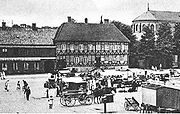
In the beginning the business was quite modest. Every step in the production process was done manually. For instance the malt mill and the waterpump were worked manually which must have been very hard work. In 1849 new ground was bought, situated a couple of hundred meters from the brewery. On the new ground there was an old bastion from early 17th century, placed next to the old moat. The purpose of the bastion was to protect the town from enemies from the west - hence the name "Wester Katt". Remains of the old city defense wall can still be seen in Krönleins's Pub. The purchase of the ground had two purposes. An ice cellar was built and control was gained over the water supply. A malting for the production of malt was also built. Below the bastion was a well with spring water, where many citizens in Halmstad fetched their water. The water was of very high quality - pure with a fresh natural taste. It is from this well that Krönleins has taken its water since the start in 1836. If you use your imagination you can picture how the water was put into huge barrels and then taken by horse carriage through town.
Munich beer
When MunichMunich
Munich The city's motto is "" . Before 2006, it was "Weltstadt mit Herz" . Its native name, , is derived from the Old High German Munichen, meaning "by the monks' place". The city's name derives from the monks of the Benedictine order who founded the city; hence the monk depicted on the city's coat...
beer was first introduced in Sweden in 1843, it was hard to persuade people to drink it. Munich beer was too dark and not sweet enough. The man who introduced this beer in Sweden was Fredrik Rosenquist. His brewery was called "The German
Germany
Germany , officially the Federal Republic of Germany , is a federal parliamentary republic in Europe. The country consists of 16 states while the capital and largest city is Berlin. Germany covers an area of 357,021 km2 and has a largely temperate seasonal climate...
Brewery" and was situated in Stockholm
Stockholm
Stockholm is the capital and the largest city of Sweden and constitutes the most populated urban area in Scandinavia. Stockholm is the most populous city in Sweden, with a population of 851,155 in the municipality , 1.37 million in the urban area , and around 2.1 million in the metropolitan area...
. The taste of the new beer was less sweet and it contained more carbon dioxide. The storage time was longer and the beer itself was definitely of higher quality than "svensköl". The introduction of the Munich beer was greatly helped by, for the time, modern marketing methods and the fact that the Swedish Royal Court became one of the company's biggest customers. The Queen's mother, of German heritage, had until 1843 bought her beer from Germany, but of course the German brewery around the corner became her new supplier. After only ten years Munich beer was the most popular beer in Sweden. It is worth mentioning that beer in Sweden has fought a hard and unjust battle with aquavit since medieval times. The brewers had a monopoly of the very profitable aquavit production and were not too interested in selling beer of high quality. This trend was broken with Munich beer and the Swedes finally had a good alternative to aquavit.
There are conflicting sources of information as to when Appeltofft started to brew Munich beer. According to one source it was brewed from the start, but that is not very likely given the above information about the introduction in 1843. Another source says it was in the 1850s but most likely it must have been in the late 1840s. Munich beer requires, as mentioned before, longer storage time than "svensköl" and we know that Krönleins had the possibility to store Munich beer in the ice cellar that was built in 1849. The fact is that the cellar was probably built for this purpose. In any case, Krönleins was well ahead in this respect compared to many other Swedish breweries. The local competitor "Östra Bryggeriet" did not start brewing Munich beer until 1863.
The Brewery into Ltd Co
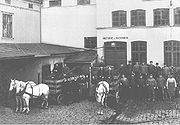
The founder Anders Julius Appeltofft died in 1851 of pneumonia - caught on a cold September night at a local restaurant. His widow ran the business until 1855 when their son Per Gustav Appeltofft took over, being the oldest of 8 brothers and sisters. Krönleins was by now in need of capital so the brewery was transformed into a joint stock company in 1861, which is one of the dates that can be seen on the facade of the brew house. The same year it is noted that the staff consisted of one brewer, one book-keeper, one cellar maid, nine brewer- and two stable boys as well as two more boys for cleaning the bottles etc. The business was still quite modest but a period of modernization and expansion began. The company board realized in 1867 that the cost of the water transportation by horse carriage could be lowered by building a pipeline from the well to the brewery. The project developed into Halmstad's first permanent pipeline with many subscribers to get water. The brewery also made an agreement with the fire department to always have the water reservoir filled with water in the event of fires. This was in 1870 – 15 years before the city itself could offer such service.
Pilsner beer
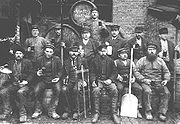
When pilsner beer was first brewed in Sweden in the 1870s, the market consisted of Munich beer that totally dominated the market, and a new kind of bottom-fermented beer called "Swedish lager". As perhaps many of you know, the original pilsner came from the town Pilsen in the present Czech Republic
Czech Republic
The Czech Republic is a landlocked country in Central Europe. The country is bordered by Poland to the northeast, Slovakia to the east, Austria to the south, and Germany to the west and northwest....
where it had been brewed for a couple of decades. The pilsner filled a gap in the Swedish beer market. Pilsner was easy to drink, less sweet with a notable hop-bitterness and lighter in colour than other beers. As is often the case, the Swedes were a bit slow in accepting a novelty and pilsner first became a success after deliberate marketing efforts were made towards the upper-class in Stockholm
Stockholm
Stockholm is the capital and the largest city of Sweden and constitutes the most populated urban area in Scandinavia. Stockholm is the most populous city in Sweden, with a population of 851,155 in the municipality , 1.37 million in the urban area , and around 2.1 million in the metropolitan area...
. However, it would still take some time until pilsner was accepted throughout Sweden. This did not happen until after World War I
World War I
World War I , which was predominantly called the World War or the Great War from its occurrence until 1939, and the First World War or World War I thereafter, was a major war centred in Europe that began on 28 July 1914 and lasted until 11 November 1918...
.
The business moves
In 1897, the company decided to move the business from Stora Torg to its present premises on "Wester katt" i.e. next to the well. A new house for brewing and malting was built in 1897-98, and it is still in use today. Apart from the brewhouse another building was built to house a fermentation basement and a cool ship. Electricity and steam entered the scene and turned the manual labour into something that more and more resembled an industry. In 1905 an electrical cooling machine was acquired which made the cooling of the wort and the fermented beer a lot easier. Before the cooling machine was taken into operation they used ice from frozen lakes!The brewing industry
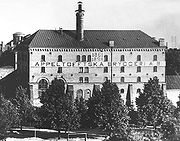
The turn of the century
Century
A century is one hundred consecutive years. Centuries are numbered ordinally in English and many other languages .-Start and end in the Gregorian Calendar:...
was to be something of a golden age for the Swedish brewing industry, a period which will probably never be equalled, at least not by the number of breweries. In 1905 there were a total of 240 beer breweries in Sweden. Every little village
Village
A village is a clustered human settlement or community, larger than a hamlet with the population ranging from a few hundred to a few thousand , Though often located in rural areas, the term urban village is also applied to certain urban neighbourhoods, such as the West Village in Manhattan, New...
or town had its own local brewery. After 1905 the number of breweries diminished gradually. A number of taxes, such as malttax, were imposed on the brewing business. These taxes were increased with time and later turned into tax of the finished product in 1940. The tax
Tax
To tax is to impose a financial charge or other levy upon a taxpayer by a state or the functional equivalent of a state such that failure to pay is punishable by law. Taxes are also imposed by many subnational entities...
of the product was then increased gradually. Not only the taxes made life hard for the brewers but also tough sales restrictions. The trend has also developed towards nationalization of the brewing industry. The reason why, is that when the state had control over the production, it was also easier to control the consumption of beer. In this tough climate the beer industry was transformed from a small-scale to a large-scale industry with only a few production units.
New owner
The next big change for the former Appeltofftska Brewery took place in 1920. The engineer Anders Krönlein took over the stock majority of the company. Extensive modernizations were made and the business grew. A new era began. New open fermentation tanks were bought. They were made of aluminium and now there was no need to take out the wooden vats once a year to rosin them, which took a lot of time and effort. The open fermentation tanks are still in use today. During the 1920s and 1930s machines gradually took over hard manual work like tapping, corking and labelling. For example, fully automatic tapping machines were installed.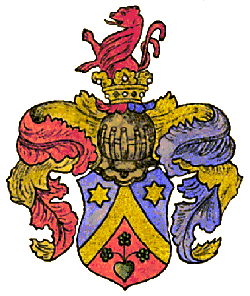
The brewery was well ahead among its competitors and a lot of effort was put into product development. During the 30's and 40's only beer of 2.8% alcohol by volume had been brewed - so called pilsner. It was now time to develop a stronger beer. As the first brewery in Sweden, Krönleins began to produce a high grade strong beer in the beginning of the 50's. The beer was given the name Three Hearts Export
Export
The term export is derived from the conceptual meaning as to ship the goods and services out of the port of a country. The seller of such goods and services is referred to as an "exporter" who is based in the country of export whereas the overseas based buyer is referred to as an "importer"...
. In the beginning the strong beer was made solely for export, since beer of this strength was prohibited in Sweden at the time.
Bottle caps became lucky-buttons in Africa
Three Hearts Export was shipped by oceanOcean
An ocean is a major body of saline water, and a principal component of the hydrosphere. Approximately 71% of the Earth's surface is covered by ocean, a continuous body of water that is customarily divided into several principal oceans and smaller seas.More than half of this area is over 3,000...
and exported all the way to the United States
United States
The United States of America is a federal constitutional republic comprising fifty states and a federal district...
with a shipping company called Broströms Tenderservice. Krönlein also managed to sell his beer to Africa
Africa
Africa is the world's second largest and second most populous continent, after Asia. At about 30.2 million km² including adjacent islands, it covers 6% of the Earth's total surface area and 20.4% of the total land area...
where the bottle caps were used in a most unexpected way. The natives of the Ivory Coast became delighted with the bottle caps with the three hearts printed on them and sewed them onto their clothes as lucky- buttons. The buttons were believed to protect you from evil spirits. The selling of strong beer became allowed in Sweden in 1955 and Three Hearts Export was soon one of the most sold brands of strong beers. Today Three Hearts Export is a true classic; it is still around with almost the same styling of the bottle.

Shortly before the next achievement, Anders Krönlein handed over to his son Hans. Hans Krönlein had studied at the most famous brewing school in Weihenstephan, Germany and holds a Diploma in Brewing. He first started as brewer
Brewer
Brewer may refer to:*Brewer, someone who makes beer by brewing*Brewer , a disambiguation page that lists people with the surname Brewer*Brewer, Maine, a city in southern Penobscot County, Maine, United States, near the city of Bangor...
in 1952 and fully succeeded his father in 1960.
The next success came in 1965 when the so called "mellanöl", or medium alcohol beer, was introduced in Sweden. The beer contained less alcohol than strong beer and could be sold outside the government controlled retail chain Systembolaget. This was an injection which was badly needed by the beer industry. Krönleins had a best seller with a medium strong beer called Three Hearts Middle Beer. Structural changes were made in the beer industry, which also affected Halmstad's two breweries. The competitor Östra Bryggeriet was bought by Krönleins in 1979. The same year Krönleins also stopped producing their own malt.
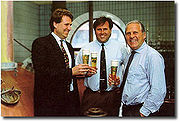
Hans Krönlein was the head of the company until 1991 when his two sons Carl and Tage took over. Hans remains as head of the board. Before Hans Krönlein handed over to his sons something of significance happened that supplied the finishing touch of a long and successful brewing career. He developed a beer that won first prize in The Brewing Industry International Awards 1990 for Lager type beer. The beer was called Crocodile Export Lager and was soon a success in the Swedish market, especially if you take into account the small size of the brewery.
Krönleins today
With regard to its owner structure, Krönleins Brewery Inc is a very stable company. The Krönlein familyFamily
In human context, a family is a group of people affiliated by consanguinity, affinity, or co-residence. In most societies it is the principal institution for the socialization of children...
has had total ownership
Ownership
Ownership is the state or fact of exclusive rights and control over property, which may be an object, land/real estate or intellectual property. Ownership involves multiple rights, collectively referred to as title, which may be separated and held by different parties. The concept of ownership has...
over the company since the 1920s, and it has been their firm conviction to keep it the same way in the future. The Krönleins have a long and strong brewing tradition of six generations of brewers. This tradition gives Krönleins a unique position in the Swedish brewing industry today. Not only do the Krönleins savour that tradition but also think ahead and use new technology to communicate with the market. Krönleins has f.ex. been on Internet with a homepage of their own since Nov 1995.
Products
The company produces a range of beers, ciders, spirits, soft drinks and water. They specialise in adding flavourings to vodka, beer, cider, etc.The cider brand is Halmstad which is produced in approx 10 different flavours including Wildberry, Dry Lime and Apple. The main soft drinks brand name is Three Hearts, a brand name which is also used for a range of beers and some bottled water. The main brand name for the water is Aqua Cristall.
Beer
In addition to the Three Hearts brand the company produces:- Borg VikingVikingThe term Viking is customarily used to refer to the Norse explorers, warriors, merchants, and pirates who raided, traded, explored and settled in wide areas of Europe, Asia and the North Atlantic islands from the late 8th to the mid-11th century.These Norsemen used their famed longships to...
BeerBeerBeer is the world's most widely consumed andprobably oldest alcoholic beverage; it is the third most popular drink overall, after water and tea. It is produced by the brewing and fermentation of sugars, mainly derived from malted cereal grains, most commonly malted barley and malted wheat... - CrocodileCrocodileA crocodile is any species belonging to the family Crocodylidae . The term can also be used more loosely to include all extant members of the order Crocodilia: i.e...
- K's Blåa
- K's Gröna
- KaltenbergKaltenbergKaltenberg is a municipality in the district of Freistadt in Upper Austria, Austria....
- Kaltenberg OktoberfestOktoberfestOktoberfest, or Wiesn, is a 16–18 day beer festival held annually in Munich, Bavaria, Germany, running from late September to the first weekend in October. It is one of the most famous events in Germany and is the world's largest fair, with more than 5 million people attending every year. The...
- King LionLionThe lion is one of the four big cats in the genus Panthera, and a member of the family Felidae. With some males exceeding 250 kg in weight, it is the second-largest living cat after the tiger...
- König Ludwig Dunkel
- Liten Ljus Lager
- Skåne Guld
- StockholmStockholmStockholm is the capital and the largest city of Sweden and constitutes the most populated urban area in Scandinavia. Stockholm is the most populous city in Sweden, with a population of 851,155 in the municipality , 1.37 million in the urban area , and around 2.1 million in the metropolitan area...
Fine FestivalFestivalA festival or gala is an event, usually and ordinarily staged by a local community, which centers on and celebrates some unique aspect of that community and the Festival....
Beer - Weihenstephan Weissbier
Spirits
- Znaps Black JackBlack JackBlack Jack or Blackjack may refer to:- Games and cards :* Blackjack, the gambling game* Black Jack , also known as Switch, a name given to some variations of Crazy Eights in United Kingdom* The black Jack playing card- Products :...
VodkaVodkaVodka , is a distilled beverage. It is composed primarily of water and ethanol with traces of impurities and flavorings. Vodka is made by the distillation of fermented substances such as grains, potatoes, or sometimes fruits.... - Znaps LemonLemonThe lemon is both a small evergreen tree native to Asia, and the tree's ellipsoidal yellow fruit. The fruit is used for culinary and non-culinary purposes throughout the world – primarily for its juice, though the pulp and rind are also used, mainly in cooking and baking...
Lime Vodka - Znaps VanillaVanillaVanilla is a flavoring derived from orchids of the genus Vanilla, primarily from the Mexican species, Flat-leaved Vanilla . The word vanilla derives from the Spanish word "", little pod...
Vodka - Znaps BlackcurrantBlackcurrantBlackcurrant, Ribes nigrum, is a species of Ribes berry native to central and northern Europe and northern Asia, and is a perennial....
Vodka - Znaps BlackthornBlackthornPrunus spinosa is a species of Prunus native to Europe, western Asia, and locally in northwest Africa. It is also locally naturalised in New Zealand and eastern North America....
Vodka - Znaps ElderElderberrySambucus is a genus of between 5 and 30 species of shrubs or small trees in the moschatel family, Adoxaceae. It was formerly placed in the honeysuckle family, Caprifoliaceae, but was reclassified due to genetic evidence...
Vodka - Znaps RoseRoseA rose is a woody perennial of the genus Rosa, within the family Rosaceae. There are over 100 species. They form a group of erect shrubs, and climbing or trailing plants, with stems that are often armed with sharp prickles. Flowers are large and showy, in colours ranging from white through yellows...
s Vodka - Znaps Wild StrawberryStrawberryFragaria is a genus of flowering plants in the rose family, Rosaceae, commonly known as strawberries for their edible fruits. Although it is commonly thought that strawberries get their name from straw being used as a mulch in cultivating the plants, the etymology of the word is uncertain. There...
Vodka - Znaps AppleAppleThe apple is the pomaceous fruit of the apple tree, species Malus domestica in the rose family . It is one of the most widely cultivated tree fruits, and the most widely known of the many members of genus Malus that are used by humans. Apple grow on small, deciduous trees that blossom in the spring...
Vodka - Hart Brothers Blended WhiskyWhiskyWhisky or whiskey is a type of distilled alcoholic beverage made from fermented grain mash. Different grains are used for different varieties, including barley, malted barley, rye, malted rye, wheat, and corn...
- Hart Brothers The Macallan 12 years WhiskyWhiskyWhisky or whiskey is a type of distilled alcoholic beverage made from fermented grain mash. Different grains are used for different varieties, including barley, malted barley, rye, malted rye, wheat, and corn...
Export
Today Krönleins is exporting to many countries, they are also well presented in Germany's big beer market.Krönleins now exports Stockholm Fine Festival (also known as: Stockholm Premium Lager) to United States of America

